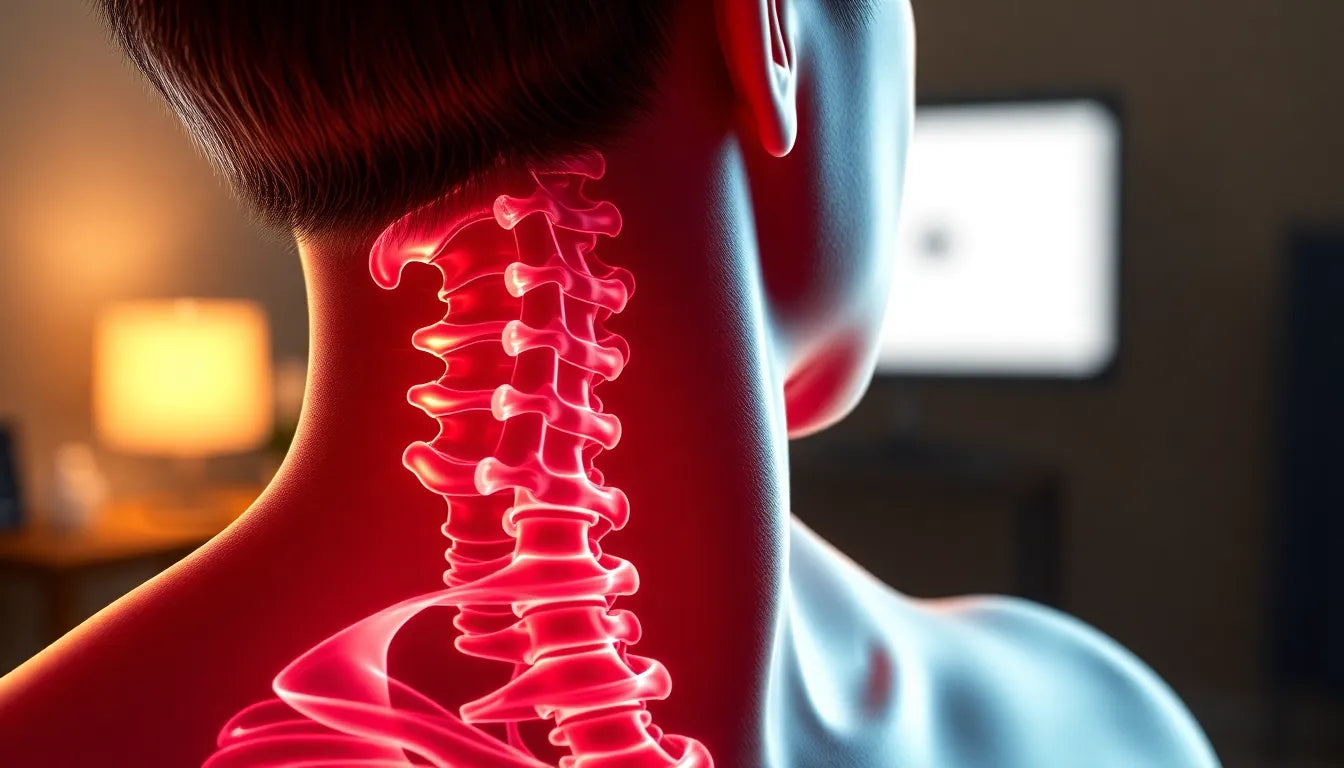Dealing with a herniated disc can be a daunting experience, especially when it comes to getting a good night's sleep. A herniated disc occurs when the soft cushion of tissue between the bones in your spine pushes out, often pressing on nearby nerves. This condition can lead to significant pain and discomfort, particularly at night, when finding a comfortable sleeping position becomes a challenge. The pain can disrupt sleep, leading to a cycle of fatigue and increased discomfort, which can hinder recovery and affect overall well-being.
Quality sleep is crucial for recovery and maintaining overall health, especially when dealing with a herniated disc. During sleep, the body undergoes repair processes, and sufficient rest is essential to manage pain and inflammation. This blog aims to offer practical, evidence-based tips that can help you sleep more comfortably despite the challenges posed by a herniated disc.
The role of sleep positions in spinal health
One of the key factors that can influence your sleep quality when dealing with a herniated disc is your sleeping position. Different sleeping positions can either alleviate or exacerbate the symptoms of a herniated disc. For instance, certain positions can help maintain spinal alignment and reduce pressure on the affected area, offering relief and promoting better sleep. Conversely, other positions may increase strain on the spine, leading to heightened discomfort and disrupted sleep.
In this guide, we will explore optimal sleeping positions that can help manage herniated disc symptoms, along with advice on choosing the right mattress and pillow to support your spine. By understanding how these elements work together, you can create a sleep environment that promotes comfort and helps you achieve restful nights. Whether it's adjusting your sleeping posture or investing in supportive bedding, making informed choices can significantly impact your sleep quality and overall health.
Optimal sleeping positions for herniated discs
When dealing with a herniated disc, selecting the right sleeping position is crucial for minimizing discomfort and promoting spinal health. One of the most recommended positions is back sleeping. This position helps maintain the spine's natural alignment, reducing pressure on the herniated disc. To enhance this position, place a pillow under your knees. This simple adjustment supports the natural curve of the spine and alleviates pressure on the lower back, making it a preferred choice for many suffering from this condition.
Another beneficial position is side sleeping with a pillow between the knees. This approach helps keep the spine aligned and reduces stress on the lower back. The pillow acts as a spacer, preventing the upper leg from pulling the spine out of alignment, which can further aggravate herniated disc symptoms. For those who find this position comfortable, it's essential to use a supportive pillow to maintain the correct posture throughout the night.
The fetal position is also widely recommended for those with herniated discs. By curling up on your side with your knees drawn towards your chest, this position opens up the space between the vertebrae, potentially relieving pressure on the disc. This position can be particularly beneficial for those who find comfort in a more curled-up posture.
For some, reclining and supportive positions can offer significant relief. Using additional pillows or a wedge pillow to elevate the legs can help reduce pressure on the spine. This position is similar to the reclining feature of a chair, which some individuals find comfortable for both resting and sleeping. By experimenting with different angles and supports, you can find a setup that works best for your specific needs.
While stomach sleeping is generally discouraged for those with herniated discs due to the strain it places on the neck and back, some individuals may still prefer this position. If you choose to sleep on your stomach, consider placing a pillow under your stomach and hips to help reduce spinal misalignment. This modification can help alleviate some of the pressure and make this position more manageable.
Mattress and pillow considerations
Choosing the right mattress and pillows can significantly impact your sleep quality and comfort when managing a herniated disc. A medium-firm mattress is often recommended as it provides adequate support for spinal alignment without being too soft or too hard. An overly soft mattress can lead to misalignment, while a hard mattress may not offer enough cushioning, both of which can exacerbate symptoms.
In addition to the mattress, supportive pillows play a crucial role in maintaining proper alignment and comfort. Placing a pillow under the knees when sleeping on your back, between the legs when side sleeping, or under the lower back for added support can make a significant difference. These strategic pillow placements help maintain the spine's natural curves and reduce pressure on the herniated disc, contributing to a more restful night's sleep.
General sleep tips for herniated disc sufferers
In addition to optimizing your sleeping position and bedding, there are general tips that can help improve sleep quality for those with a herniated disc. Avoid sleeping on the side where the pain is more intense, as this can increase discomfort. Adjusting your sleeping setup based on the location of the herniated disc, whether in the neck or lower back, can also provide targeted relief.
Consider incorporating ergonomic aids if standard adjustments don’t provide enough relief. Specialized pillows, mattress toppers, or even adjustable beds can offer additional support and comfort. By tailoring your sleep environment to your specific needs, you can significantly enhance your ability to sleep soundly despite the challenges posed by a herniated disc.
Additional lifestyle and sleep adjustments
Beyond choosing the right sleeping position and bedding, adopting a consistent sleep routine can significantly impact your ability to manage pain and improve sleep quality when dealing with a herniated disc. Establishing a regular sleep schedule helps regulate your body's internal clock, promoting deeper and more restorative sleep. Aim to go to bed and wake up at the same time every day, even on weekends, to maintain this rhythm.
Incorporating gentle stretching or relaxation techniques before bed can also be beneficial. Activities such as yoga or simple stretching exercises can help ease muscle tension and improve flexibility, potentially reducing the discomfort associated with a herniated disc. Additionally, relaxation techniques like deep breathing or meditation can calm the mind, making it easier to fall asleep and stay asleep throughout the night.
Quick reference guide to sleeping positions and supports
| Sleeping Position | Pillow Placement | Mattress Tip |
|---|---|---|
| Back Sleeping | Pillow under knees | Medium-firm mattress |
| Side Sleeping | Pillow between knees | Medium-firm mattress |
| Fetal Position | Pillow between knees (optional) | Medium-firm mattress |
| Reclining Position | Wedge pillow to elevate legs | Medium-firm mattress |
| Stomach Sleeping | Pillow under stomach and hips | Medium-firm mattress |
Frequently Asked Questions
What is the best sleeping position for a herniated disc?
Back sleeping with a pillow under the knees is often recommended for optimal spinal alignment, as it helps maintain the spine's natural curve and reduces pressure on the lower back.
Can I sleep on my stomach if I have a herniated disc?
Sleeping on your stomach is generally discouraged due to the strain it places on the neck and back. However, if you prefer this position, placing a pillow under your stomach and hips can help minimize spinal strain.
How can I choose the right mattress for a herniated disc?
Opt for a medium-firm mattress that supports spinal alignment without being too soft or too hard. This balance helps maintain the spine's natural position and reduces pressure on the herniated disc.
What other ergonomic aids can help improve sleep with a herniated disc?
Consider using specialized pillows, mattress toppers, or adjustable beds for added support and comfort. These aids can enhance your sleep environment and help alleviate discomfort associated with a herniated disc.
Conclusion
Finding the right sleep position and support is crucial for managing herniated disc symptoms effectively. By experimenting with different setups and incorporating lifestyle adjustments, you can discover what works best for your individual needs. Prioritizing comfort and spinal alignment through informed choices will contribute significantly to achieving restful nights and supporting your overall well-being.
Sources
- New York Spine Institute. "Practical Advice for Sleeping with a Herniated Disc."
- NY Bone and Joint. "Medical and Clinical Insights on Sleeping Positions."
- Pain and Spine Institute. "Comprehensive Guidance on Sleeping with a Herniated Disc."
- Florida Surgery Consultants. "Step-by-Step Positioning for Sleep."
- Total Ortho Sports Medicine. "Sleeping Tips for Slipped Discs."
- Phoenix Rehab. "Physiotherapy Approach to Sleeping with a Herniated Disc."
- Mayo Clinic. "General Sleep Support and Mattress Considerations."


















